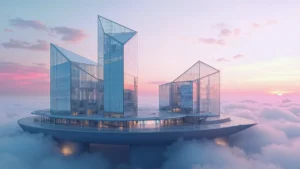The Future of Buildings: Why Retrofitting Is the Key to Energy Efficiency and Net-Zero Goals?
Buildings account for a significant share of global energy consumption and carbon emissions. As sustainability regulations tighten and operational costs rise, retrofitting existing buildings has emerged as one of the most effective strategies to achieve energy efficiency, improve occupant comfort, and extend asset life.
Unlike new construction, retrofits maximize the value of existing structures by integrating modern technologies, high-performance materials, and smarter systems — all without the environmental cost of demolition and rebuilding. For property owners, businesses, and communities alike, retrofitting represents a transformational pathway toward sustainability, cost optimization, and long-term resilience.
What is Retrofitting?
Retrofitting is the process of upgrading existing buildings with advanced systems, materials, and technologies to improve energy performance, functionality, and sustainability. It is not a one-size-fits-all solution; rather, it is a strategic approach tailored to the specific needs of each building.
Key retrofit interventions typically include:
- Installing high-performance insulation to minimize energy loss.
- Upgrading to energy-efficient windows and glazing systems.
- Deploying modern HVAC solutions designed for lower energy consumption.
- Enhancing airtightness through membranes and sealants to reduce uncontrolled heat exchange.
- Integrating smart building technologies for real-time monitoring and optimization.
- Leveraging renewable energy systems like solar PVs and heat pumps to complement efficiency gains.
At ECMC, our retrofitting methodology combines engineering expertise with deep sustainability insights, ensuring every upgrade drives measurable performance improvements while aligning with global net-zero goals.
The Key Benefits of Retrofitting
- Driving Energy Efficiency and Cost Optimization
Energy efficiency is the cornerstone of any retrofit strategy. By targeting energy loss points such as walls, roofs, windows, and outdated HVAC systems, retrofits significantly reduce overall consumption.
Studies show that comprehensive retrofit projects can deliver up to 60–80% reductions in energy usage when combined with airtightness strategies, insulation upgrades, and renewable integrations.
Strategic energy efficiency measures include:
- Improved insulation to stabilize indoor temperatures.
- Airtight membranes to minimize heat loss and uncontrolled ventilation.
- LED lighting systems designed for low energy draw.
- Smart controls and sensors to monitor and regulate consumption patterns.
For property owners, these upgrades translate into lower utility bills, predictable operational expenses, and improved long-term asset value. In markets where energy prices are volatile, energy-optimized buildings create a significant competitive advantage.
- Reducing Carbon Footprints and Enabling Net-Zero Targets
Retrofitting existing structures plays a pivotal role in global climate strategies. Buildings contribute nearly 40% of global carbon emissions, and retrofitting is one of the most cost-effective ways to accelerate decarbonization.
By improving energy performance and integrating renewable energy systems, retrofits:
- Minimize dependency on fossil fuels.
- Enable the adoption of heat pumps, solar panels, and energy storage systems.
- Support compliance with emerging environmental regulations and carbon reduction frameworks.
For corporations and developers, this translates into stronger alignment with ESG commitments and future-proofing against tightening sustainability reporting requirements.
- Enhancing Indoor Comfort, Health, and Well-being
Retrofitting is not just about energy savings; it is about creating better living and working environments. High-quality insulation, airtight seals, and optimized ventilation systems maintain consistent indoor temperatures and improve air quality by filtering pollutants and controlling humidity.
Health and comfort benefits include:
- Eliminating drafts and cold spots.
- Preventing condensation and mold growth.
- Ensuring proper ventilation to reduce airborne contaminants.
- Supporting occupant well-being through stable, comfortable indoor environments.
For businesses, enhanced comfort drives productivity and employee satisfaction, while residential property owners benefit from improved quality of life and tenant retention.
- Boosting Property Value and Market Competitiveness
Sustainability is increasingly shaping real estate demand. Energy-efficient buildings are not only cheaper to operate but also more attractive to investors, tenants, and buyers.
Key drivers of enhanced property value through retrofitting:
- Lower operational costs appeal to cost-conscious tenants.
- Compliance with sustainability certifications (e.g., LEED, BREEAM) boosts market positioning.
- ESG-aligned buildings command premium rental rates in competitive markets.
For owners, investing in retrofits strengthens both the financial return and the market desirability of their properties, ensuring long-term growth.
- Extending Building Lifespan and Structural Integrity
Older buildings face challenges such as thermal bridging, poor ventilation, outdated mechanical systems, and moisture ingress. Left unaddressed, these issues lead to costly repairs and premature asset depreciation.
Retrofitting solves these challenges by:
- Reinforcing thermal insulation to prevent condensation damage.
- Replacing outdated HVAC systems with durable, energy-efficient alternatives.
- Upgrading building envelopes to reduce exposure-related wear and tear.
The result is a longer-performing structure that remains compliant, efficient, and operationally resilient for decades to come.
Retrofitting as a Catalyst for Sustainability Leadership
Retrofitting is no longer just a technical intervention to improve building performance — it has become a strategic lever for sustainability leadership. With the growing pressure of net-zero mandates, ESG disclosures, and investor expectations, companies, property owners, and developers are now judged not only by financial outcomes but also by their contribution to environmental and social progress.
For many organizations, existing building stock represents one of the largest contributors to operational emissions. The construction sector alone accounts for nearly 40% of global CO₂ emissions, and more than 70% of today’s buildings are expected to still be in use by 2050. In this context, relying exclusively on new, energy-efficient developments is not enough to meet climate targets — upgrading the current built environment is essential.
Retrofitting enables organizations to:
- Accelerate decarbonization strategies by cutting energy demand and reducing dependency on fossil fuels.
- Improve ESG ratings and reporting credibility through tangible, measurable actions aligned with frameworks like CSRD, ISSB, and TCFD.
- Attract sustainability-focused investors who increasingly direct capital toward climate-resilient assets.
- Enhance corporate reputation by demonstrating a proactive stance on sustainability, resource efficiency, and community well-being.
The Role of Smart Technologies in Retrofit Projects
In the past, retrofits focused largely on replacing outdated materials and mechanical systems. Today, the equation has evolved: digital transformation is redefining what a high-performance, energy-efficient building looks like. By leveraging smart technologies, property owners gain real-time visibility, data-driven insights, and predictive control over energy use — unlocking new levels of operational efficiency and sustainability impact.
- Data-Driven Performance Monitoring
Internet of Things (IoT) sensors embedded throughout buildings continuously track energy consumption, air quality, humidity levels, and occupancy patterns. These data streams feed into cloud-based energy management systems that provide actionable insights, enabling operators to pinpoint inefficiencies instantly and make informed decisions.
- Predictive Maintenance and Fault Detection
With AI-powered fault detection and predictive analytics, smart retrofits minimize downtime and reduce unexpected failures. For example, machine learning algorithms can identify HVAC performance anomalies before they become costly breakdowns, ensuring uninterrupted comfort and operational reliability.
- Intelligent Climate Control and Automation
Smart thermostats, adaptive lighting systems, and occupancy-based automation ensure that energy is used only where and when it is needed. These tools balance user comfort with energy optimization — a critical advantage for large commercial and mixed-use properties where overconsumption is common.
- Integrating Renewable Energy Management
Retrofitted buildings increasingly pair solar PV systems, battery storage, and heat pumps with advanced energy management platforms. These platforms automatically optimize grid interaction, ensuring that renewable energy is used efficiently and minimizing dependency on external supply.
Strategic Takeaways for Building Owners and Developers
Retrofitting is no longer an optional exercise — it is a strategic necessity for property owners, investors, and developers navigating an increasingly competitive, sustainability-driven market. However, successful retrofits require data-backed planning, phased implementation, and expert execution.
Here is a practical roadmap for maximizing retrofit value:
- Begin with a Comprehensive Energy Audit
A detailed energy audit establishes a baseline for performance, uncovering inefficiencies in insulation, HVAC systems, lighting, and energy controls. By understanding where energy is being lost, stakeholders can prioritize interventions with the highest ROI.
- Develop a Phased Retrofit Strategy
Large-scale retrofits do not need to happen all at once. A phased approach ensures investments are sequenced for maximum efficiency, starting with high-impact upgrades such as airtightness improvements, insulation enhancements, and HVAC optimization, followed by renewable integration and digital solutions.
- Integrate Smart Technologies and Analytics
Energy optimization does not stop at physical upgrades. Smart technologies — including IoT, predictive maintenance, and building automation systems — ensure continuous performance tracking and operational excellence.
- Align Retrofits with ESG and Regulatory Frameworks
Regulators worldwide are tightening sustainability mandates. Aligning retrofit strategies with emerging disclosure frameworks (ISSB, CSRD, SEC, and others) not only ensures compliance but also strengthens corporate ESG credibility and investor appeal.
- Partner with Expert Retrofit Specialists
Working with a technical partner like ECMC ensures that every aspect of the retrofit — from material selection to system integration — is grounded in engineering precision, lifecycle cost optimization, and sustainability best practices.
Conclusion: Building the Future, Sustainably
Retrofitting represents a unique opportunity to bridge the gap between today’s aging infrastructure and tomorrow’s energy-efficient future. Through strategic interventions, businesses and property owners can achieve significant energy savings, comply with emerging ESG regulations, and create healthier spaces for occupants — all while extending asset value and supporting global net-zero ambitions.
At ECMC, we deliver integrated energy efficiency and retrofitting solutions designed to meet the evolving demands of modern infrastructure. By combining engineering precision with sustainability leadership, we help clients transform their buildings into high-performing, future-ready assets.






